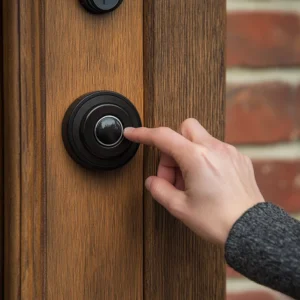Kevin had already made his Halloween costume with his mom and helped his dad decorate their house. He was excited about how much candy he would collect. But one house on his street didn’t have any decorations, and that kept bothering him. He didn’t understand why someone wouldn’t celebrate Halloween, so he thought maybe they needed help.
Halloween was almost here, and the entire neighborhood was buzzing with excitement. Every yard seemed to be trying to be the scariest one around.
There were pumpkins with big, jagged smiles all along the sidewalks. Plastic skeletons hung from tree branches, and fake cobwebs covered porches.
The air smelled like dry leaves and candy, and eleven-year-old Kevin could feel his heart racing with excitement.

Halloween was Kevin’s favorite day of the year, a time when anyone could be whatever they wanted. He loved how everything changed for that one magical night.

As he walked down the street, he smiled, looking at the glowing jack-o’-lanterns and spooky ghosts decorating the houses. Some homes even played creepy sounds like witches’ laughter and creaking doors.

But something different caught his eye as he went farther down the street. One house was dark and plain, with no decorations at all. It was Mrs. Kimbly’s house.

Mrs. Kimbly was an older woman who lived alone. Kevin had helped her before, mowing her lawn in summer and shoveling snow in winter, but she rarely said much. Her undecorated house seemed out of place in the festive neighborhood.

Kevin felt bad that her house had no Halloween spirit. He thought maybe she needed help with the decorations. Determined, he crossed the street and knocked on her door.

When Mrs. Kimbly answered, her face showed annoyance. “What do you want, Kevin?” she asked in a gruff voice.

“I noticed you don’t have any Halloween decorations. I could help you put some up, if you’d like,” Kevin offered.

Mrs. Kimbly frowned. “I don’t need decorations, and I don’t need help,” she said sharply before slamming the door.

Kevin was surprised. How could anyone hate Halloween so much? He didn’t want her house to be a target for pranks, like kids throwing toilet paper, so he came up with a plan.

At home, Kevin told his mom, Sarah, about Mrs. Kimbly’s undecorated house and how she had slammed the door in his face. His mom suggested leaving her alone, explaining that people might have reasons for not celebrating.

But Kevin didn’t think Mrs. Kimbly hated Halloween—she seemed lonely. So, he decided to help anyway.

He gathered all the Halloween decorations he could find, including his favorite pumpkin, and hurried back to Mrs. Kimbly’s house. He carefully hung lights and placed pumpkins on her porch. As he finished, the front door opened, and Mrs. Kimbly stormed out, furious.

“I told you not to decorate my house!” she yelled. She grabbed Kevin’s carved pumpkin and smashed it on the ground. Kevin was shocked and hurt, but he whispered, “I just wanted to help,” before running home.

That night, Kevin put on his vampire costume, but he couldn’t enjoy Halloween. He was worried about Mrs. Kimbly’s house being pranked. So, he returned to her house and sat on her porch, handing out candy from his own bag to trick-or-treaters, explaining that Mrs. Kimbly wasn’t home.

As he sat alone, the door creaked open. Mrs. Kimbly stepped out, her expression softer this time.
“What are you doing here, Kevin?” she asked quietly.
“I didn’t want anyone to mess with your house,” Kevin explained. “I thought I could help.”
Mrs. Kimbly sighed and sat beside him. She admitted that Halloween was hard for her because it reminded her of how alone she was. She had no family to share it with.
Kevin understood now. “You don’t have to be alone,” he said. “You can celebrate with the rest of us.”

Mrs. Kimbly smiled sadly and thanked Kevin for his kindness. She even apologized for smashing his pumpkin. Kevin promised to bring another one so they could carve it together.
For the first time in years, Mrs. Kimbly felt the warmth of Halloween again, thanks to the caring heart of one determined boy.
Devastating Hurricane Milton Hits Florida – Are You in the Danger Zone?
Darkness fell as the storm hit Florida’s Gulf Coast, bringing deadly tornadoes and heavy flooding. Millions lost power, and many communities were left in ruins.

Hurricane Milton, a strong Category 3 storm, made landfall near Siesta Key in Sarasota County, Florida, on October 9, around 8:30 in the evening.
With winds over 120 miles per hour and heavy rain, the hurricane caused major damage. More than 1.1 million homes and businesses lost power, especially in Sarasota, Manatee, and Hardee counties.

The Florida Division of Emergency Management (FDEM) posted on Facebook, urging people to stay inside and remain alert.
As the hurricane approached, tornadoes tore through St. Lucie County, causing severe damage and deaths. Sheriff Keith Pearson confirmed “multiple fatalities” in a senior community near Fort Pierce.
The exact number of deaths is still unknown as rescue teams search for survivors. “They are listening for life,” Pearson said, describing efforts to find people in the wreckage.

St. Lucie County has suffered massive destruction. County spokesman Erick Gill said, “Dozens of homes have been damaged, some with catastrophic damage.”
Statewide, about 125 homes were destroyed, mostly in senior mobile home communities, according to FDEM Director Kevin Guthrie. Emergency workers are working nonstop to help those affected.
Governor Ron DeSantis said the storm caused 116 tornado warnings across the state, with 19 tornadoes confirmed. The damage from Hurricane Milton is widespread.

In St. Petersburg, a rare rainfall event occurred, with over nine inches of rain in just three hours. This was more rain than the city usually gets in three months.

An advisory on October 10 from the National Weather Service warned of flash floods in parts of west-central Florida. Strong winds also continued to hit the east coast.
By 1:00 a.m. Eastern Time, St. Petersburg had winds of 48 mph, with gusts up to 79 mph. Orlando recorded winds of 46 mph, with gusts of 74 mph, and Cape Canaveral had winds of 52 mph, with gusts up to 67 mph.



Leave a Reply